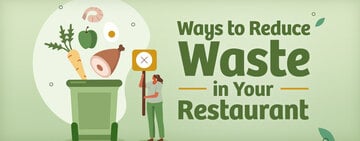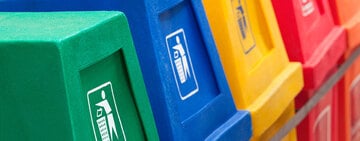
Restaurants are among the top water-consuming establishments across the country. According to the EPA, the average restaurant’s water usage is around 5,800 gallons of water per day, which can add up to 25,000 to 300,000 gallons of water per year. Implementing water saving practices in your kitchen, restrooms, and throughout your facility not only helps conserve this precious resource but also reduces utility costs. We created a list of water saving tips for your business so you can learn how to lower your water bill and reduce your environmental impact.
How to Save Water in Your Restaurant
Water Saving Tips in the Kitchen

It is expected that approximately 52% of water usage in restaurants originates in the kitchen. Between dishwashing, food prep, and cooking, water is used in almost every aspect of foodservice. We’ll teach you how to save water in the kitchen with some simple changes:
1. Use Energy Star Appliances
Investing in Energy Star-rated kitchen appliances can not only save energy, but they can also significantly reduce water consumption. Energy Star appliances meet strict energy efficiency guidelines set by the U.S. Environmental Protection Agency (EPA) and the U.S. Department of Energy. Energy Star-rated dishwashers, ice machines, and refrigeration units are designed to be more water-efficient while still delivering high performance, helping to reduce both water consumption and utility costs.
2. Make Dishwashing Changes
Implementing water saving practices in the dishwashing process can lead to substantial water conservation.
- Choose High-Temperature Dishwashers: Opting for high-temperature dishwashers can help restaurants save water. The higher water temperature helps to sanitize dishes effectively, reducing the need for additional rinsing and chemicals compared to low-temperature dishwashers. Additionally, using commercial dishwashers with high-efficiency features, like sensors that adjust water usage based on load size, can further minimize water waste.
- Run Full Racks Only: Encourage employees to wait until the dishwasher is fully loaded before running a cycle. Running full racks ensures that you are maximizing the dishwasher's capacity and reducing the number of cycles needed throughout the day.
- Use Low-Flow Pre-Rinse Spray Valves: Pre-rinsing dishes before loading them into the dishwasher is a common practice in restaurants. However, installing low-flow pre-rinse units can significantly reduce water usage during the pre-rinsing process. These units are designed to deliver sufficient water pressure for efficient cleaning while conserving water compared to traditional pre-rinse units.
3. Install Air-Cooled Ice Machines
When it comes to water-saving initiatives in your restaurant, installing air-cooled ice machines can make a significant impact. These machines are more efficient than water-cooled models, as they use air to cool the condenser coils instead of water. This means less water is wasted during the ice-making process, helping you reduce your restaurant's overall water consumption. Some states even prohibit water-cooled ice machines entirely due to their high water consumption.
Air-cooled ice machines are easier to install and maintain compared to water-cooled models. They require less frequent cleaning and are less prone to scale buildup, which can further contribute to water conservation efforts in your establishment. By opting for air-cooled ice machines, restaurants can reduce water usage and lower operating costs.
4. Select a Boilerless Steamer
Boilerless steamers, or connectionless steamers, use significantly less water compared to traditional boiler-based models, due to their enclosed tank systems. While boiler steamers can use around 400 gallons of water a day, connectionless boilers need as little as 15 gallons a day (depending on the unit). With innovative technology that generates steam quickly and efficiently, these steamers not only save water but also offer fast cooking times and consistent results. Their efficient cooking process ensures that food is cooked evenly and retains its natural flavors and nutrients.
5. Use Refrigerator Thawing for Food
One method that can help restaurants save water while thawing food is using refrigerator thawing instead of running water. This method involves transferring frozen items from the freezer to the refrigerator to allow for a gradual thawing process. Refrigerator thawing is a recommended method by the USDA because it ensures that the food remains at a safe temperature and out of the danger zone throughout the thawing process. By placing frozen items in the refrigerator, the cold air surrounding the food helps to gradually thaw it without the need for running water.
Water Saving Tips in Restrooms

Restrooms in commercial establishments are often high-traffic areas that consume a significant amount of water. Implementing water saving strategies in restrooms can lead to substantial savings on water bills and contribute to environmental conservation efforts. Here are some ways you can save water in restrooms:
1. Choose WaterSense Labeled Products
Look for products with the WaterSense label, a certification program sponsored by the EPA that ensures water-efficient performance. WaterSense-labeled products, such as faucets, toilets, and showerheads, are designed to use at least 20% less water while still maintaining high-performance standards. By opting for WaterSense-labeled products, businesses can significantly reduce water usage and lower utility costs without sacrificing functionality.
2. Install Touchless Faucets
Touchless faucets are equipped with sensors that detect when hands are placed under the faucet for washing. These faucets automatically turn on the water flow and shut off after a set period, preventing unnecessary water wastage caused by forgetting to turn off the faucet. Installing automatic shut-off faucets in restrooms can help conserve water by ensuring that water is only used when needed.
In addition to water saving features, automatic faucets are ADA-compliant and easier to use for individuals with physical limitations or disabilities. By eliminating the need to touch faucet handles, touchless faucets can also help reduce the spread of germs and bacteria in the restroom.
3. Use Low-Flow Fixtures
Installing low-flow fixtures, such as low-flow toilets, urinals, and faucets, can significantly reduce water usage in restrooms. Low-flow fixtures are specifically designed to limit water flow while maintaining optimal performance. They decrease strain on plumbing systems, making them an excellent choice for commercial restroom settings where water usage is a concern. Here are some fixtures you can swap with low-flow versions:
- Toilets: Low-flow toilets use significantly less water per flush compared to traditional models. Standard toilets typically use around 1.6 gallons of water per flush, while low-flow toilets can use as little as 1.28 gallons or even less.
- Urinals: Installing waterless urinals or low-flow urinals can also contribute to water conservation efforts in commercial restrooms. Waterless urinals eliminate the need for water for flushing, while low-flow urinals use minimal water per flush.
- Faucets: Low-flow faucets reduce water flow rates without compromising water pressure, making them an efficient choice for handwashing stations in restrooms.
Water Saving Tips throughout the Facility

Reducing your restaurant’s water bill should be a collaborative effort between you and your staff. Train your employees to keep a lookout for ways to save water as they maneuver throughout your establishment. Train your staff to implement the following water saving techniques:
- Wait for Water Requests: Encourage staff to wait for specific requests for water from customers or guests rather than automatically serving water. By doing so, you can avoid unnecessary water wastage that often occurs when glasses are refilled without being emptied.
- Turn Off Running Water When Not in Use: A simple yet effective way to save water in a commercial setting is to ensure that all sources of running water are promptly turned off when not in use. Whether it's a faucet in the kitchen, an ice cream dipper well in the front of house, a hose in the outdoor area, or a water feature in a lobby, being vigilant about shutting off water sources can significantly reduce water consumption.
- Report and Fix Leaky Pipes Immediately: Leaky pipes are a common source of water waste in commercial facilities. Encourage employees to immediately report any leaks they notice so that maintenance staff can address them promptly. Fixing leaky pipes not only conserves water but also helps prevent potential water damage to the building and its infrastructure.
Implementing water saving tips in your restaurant can not only help reduce water consumption and utility costs but also contribute to environmental sustainability. By making simple changes like fixing leaks, using water-efficient equipment, and training staff on water saving practices, you can make a significant impact on your water usage. Prioritizing water conservation not only benefits your bottom line but also showcases your commitment to responsible resource management.





